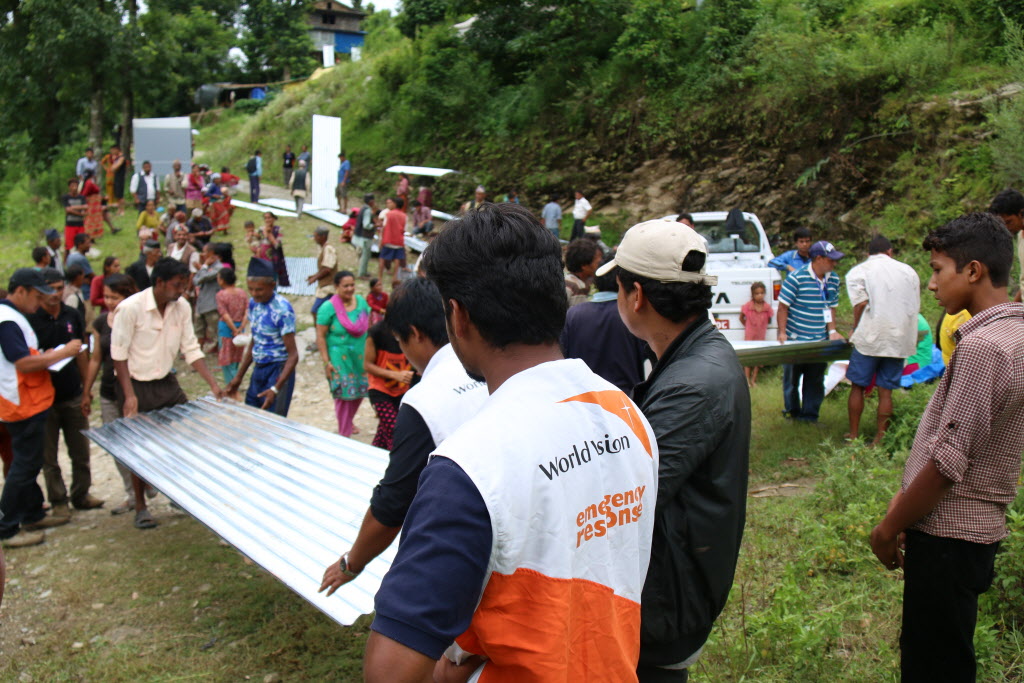
KATHMANDU (October 25, 2015) — Since the devastating 7.8 magnitude earthquake stuck Nepal back in late April, followed by a second powerful earthquake two weeks later, World Vision has reached over 229,000 beneficiaries, providing immediate relief in seven of the most affected districts. During the initial phase of the response, those most affected received both food and non-food items. Communities also benefitted from the temporary learning centers and child friendly spaces, as well as from water, sanitation & hygiene (WASH) and cash-for-work programs.
World Vision International Nepal Earthquake Response (NER) has so far distributed food and non-food items such as tarpaulins, Corrugated Galvanized Iron (CGI) sheets, sleeping mats, tents, kitchen kits, blankets, shelter tool kits, hygiene kits, mosquito nets to 43,958 households in the hardest-hit districts (Sindhupalchowk, Sindhuli, Lamjung, Lalitpur, Bhaktapur, Kathmandu and Gorkha). This support still continues to reach the doorstep of beneficiaries who need it the most.
Key to World Vision’s work is its focus on child care and child protection. Thus far more than 8,214 children have benefitted from the 54 temporary learning centers constructed in Gorkha, Sindhupalchowk, Sindhuli and Bhaktapur, and from the child friendly spaces that were immediately erected to provide a safe environment for children to play, learn and recover from this highly stressful event.
To ensure the availability of safe drinking water and hygiene, more than 700 households have now benefitted from renovated water systems, as well as the distribution of the aqua tabs, jerry cans and water purifier bags. The household toilets as well as temporary toilets have also been constructed in World Vision’s response area to minimize the probable occurrence of diseases in the aftermath of a disaster. As a part of cash-based programming, World Vision has helped more than 16,000 families to meet their immediate needs, such as food, medicines and even education.
“Working with our response field team to distribute much needed NFIs to those most affected in some of the most challenging terrain was a deeply moving experience. Their dedication and hard work is truly exceptional, and a clear example of World Vision at its best,” said Jason Katz, World Vision’s operations manager for the Nepal Earthquake Response.
World Vision in Nepal is entering its Recovery Phase in November 2015, scaling up operations to help people of Nepal build back better. For the Recovery Phase, World Vision will support communities to build resilience and restore safety for earthquake-affected children and their communities. Alongside communities and other partners World Vision will meet emergency needs, restore services to a higher standard, and empower people with skills and opportunities to sustain themselves. World Vision will prioritize the most vulnerable, fostering social inclusion and gender equity in community interactions for long-term change. World Vision’s programs will seek to increase a community’s ability to adapt to change and absorb future shocks.
“I am amazed by the resilience and recovery of Nepalese families. They have worked so hard over the last six months to meet their basic needs alongside our support. We are really happy to walk alongside families in the recovery phase as they come back to some sort of normal life, sending their children back to school, beginning to rebuild their houses and starting to think through economic opportunities. I am excited to start to think about the future with earthquake-affected communities, where children can grow happy and healthy with stronger schools, health behavior and facilities, and real economic opportunity,” said Jennifer MacCann, World Vision’s Nepal Earthquake Response director.
– END –
About World Vision:
World Vision is a Christian humanitarian organization conducting relief, development, and advocacy activities in its work with children, families, and their communities in nearly 100 countries to help them reach their full potential by tackling the causes of poverty and injustice. World Vision serves all people regardless of religion, race, ethnicity, or gender. For more information, please visit www.WorldVision.org/media-center/ or on Twitter @WorldVisionUSA.
Highlights
- World Vision transitioning from immediate relief to long-term recovery work in November 2015
- Organization has reached more than 229,000 people with immediate relief